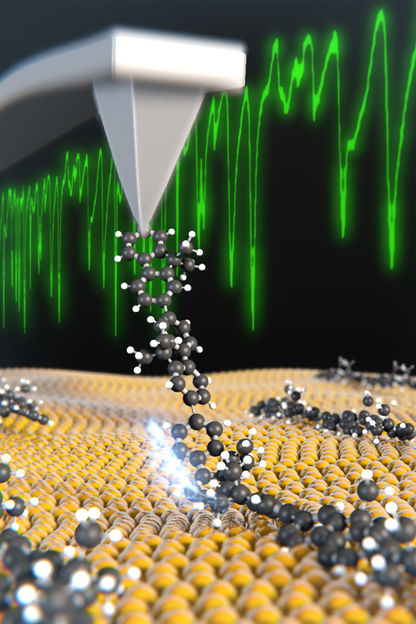Pulling polymers leads to new insights into their mechanical behavior
In collaboration with colleagues from Berlin and Madrid, researchers at the Department of Physics at the University of Basel have pulled up isolated molecular chains from a gold surface, using the tip of an atomic force microscope (AFM). The observed signal provides insight into the detachment force and binding energy of molecules. The results have been published in the renowned scientific journal PNAS.

The tip of an AFM pulling off a molecular chain vertically from a gold surface.
Shigeki Kawai
Atomic force microscopy is a method normally used for imaging matter with very high resolution. The sharp tip of the microscope is used to scan the surface line by line. The resolution is so high, that single atoms can be seen. “This method is roughly equivalent to using the tip of the Matterhorn to scan the surface of a tennis ball”, says Prof. Ernst Meyer of the Department for Physics at the University of Basel. Due to an improved method, the scientists are now able to investigate the mechanical behavior of a single polymer being pulled off a surface.
Using the tip of the AFM, the researchers were able to pull single chains of molecules (polymers) off a gold surface. “The molecule-surface interaction during pulling is so weak that each chain link (molecular unit) detaches successively. Thus, the whole chain can be pulled off almost vertically to the surface”, explains Meyer. By analyzing the observed oscillations, the researchers are able to make quantitative statements on the binding energy of each molecular unit.
Motion without friction
Furthermore, the experiments showed that the polymers could be pulled off with almost no lateral forces. This remarkable behavior of nearly frictionless motion was predicted by a theoretical model and has now been verified for molecules on a gold surface. Previously, the mechanical behavior of single polymer during pulling from a surface had never been investigated with atomic-scale resolution. The findings and calculations of the research team now provide detailed insight into this process for the first time.
Such investigations are not only of interest for the field of physics, but also for biology and chemistry, since the method of pulling polymers from surfaces can also be applied to biological molecules. So far, valuable insights have been obtianed into the folding and unfolding of DNA and proteins. Chemical reactions of small biopolymer sub units or complex polymer chains under the influence of traction forces and catalytic nanoparticles could be investigated with this new method.
Original publication
Most read news
Original publication
Shigeki Kawai, Matthias Koch, Enrico Gnecco, Ali Sadeghi, Rémy Pawlak, Thilo Glatzel, Jutta Schwarz, Stefan Goedecker, Stefan Hecht, Alexis Baratoff, Leonhard Grill and Ernst Meyer; Quantifying the atomic-level mechanics of single long physisorbed molecular chains; PNAS Early Edition
Topics
Organizations
Other news from the department science
These products might interest you

Get the analytics and lab tech industry in your inbox
By submitting this form you agree that LUMITOS AG will send you the newsletter(s) selected above by email. Your data will not be passed on to third parties. Your data will be stored and processed in accordance with our data protection regulations. LUMITOS may contact you by email for the purpose of advertising or market and opinion surveys. You can revoke your consent at any time without giving reasons to LUMITOS AG, Ernst-Augustin-Str. 2, 12489 Berlin, Germany or by e-mail at revoke@lumitos.com with effect for the future. In addition, each email contains a link to unsubscribe from the corresponding newsletter.






















































